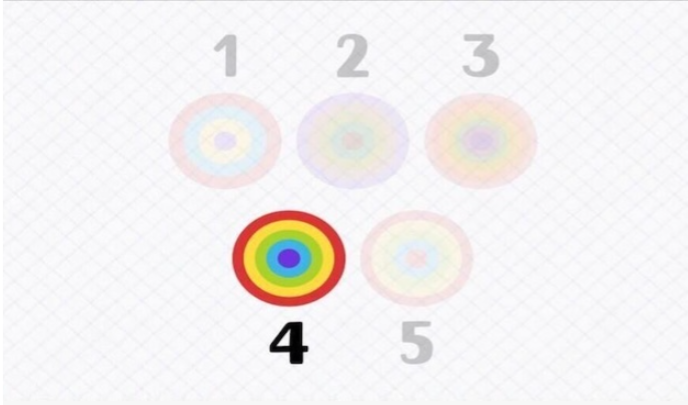Here’s a puzzle that’s colorful, tricky, and guaranteed to make you second-guess your logic. You’re shown a classic toy pyramid—five colored rings stacked from largest (bottom) to smallest (top). Each ring has a distinct color, and your challenge is simple:
If you look at the pyramid from the top, in what order will you see the colors?

It sounds easy, right? But when the five color-wheel options are laid out next to the pyramid, it becomes surprisingly difficult to choose the correct one. So, take a close look at the image. Can you figure it out before we walk through the answer?
Why This Puzzle Tricks So Many People
The challenge lies in shifting perspective. We’re used to looking at objects from the side or front—not from a bird’s-eye view. That’s exactly what this riddle plays on. It asks you to imagine how the top of the stacked rings would appear if you were looking directly down from above.
Many people immediately look for patterns or start guessing based on instinct. Others try to match the colors without fully considering how the rings are layered. And because the rings get smaller as they go up, the wrong answers can look deceivingly right.
Step-by-Step Breakdown of the Puzzle
Step 1: Understand the Pyramid Structure
You’re looking at a stack of five rings from the side view. From top to bottom, the colors are:
- Top (smallest ring): Purple
- Second: Blue
- Third: Green
- Fourth: Yellow
- Bottom (largest ring): Red
Step 2: Imagine the View from the Top
If you’re looking directly down at the top of the stack:
- You’ll see the smallest ring in the center (purple)
- Each larger ring will appear as a concentric circle underneath it, slightly wider, and visible around the edges
- So, the topmost visible part is purple, surrounded by blue, then green, then yellow, and finally red on the outermost edge
Video : Puzzle Time
Step 3: Match with the Choices Given
Now check each of the five circular diagrams presented in the image. Each one shows a different arrangement of color rings from the center outwards.
- Option 1: Red in the center—wrong
- Option 2: Purple on the outside—wrong
- Option 3: Yellow at the top—wrong
- Option 4: Purple in the center, then blue, green, yellow, and red in that order—this matches perfectly
- Option 5: Yellow in the center—wrong again
✅ Correct Answer: Option 4
Why Option 4 Is Correct
From top to bottom, the ring colors are:
- Purple (top ring)
- Blue
- Green
- Yellow
- Red (bottom ring)
Looking from above, the smallest ring is completely visible (purple), and the other colors form layers under it in concentric circles. That’s exactly what option 4 shows.

What This Puzzle Teaches Us
This colorful brain teaser does more than entertain. It helps train your:
- Spatial awareness – visualizing 3D objects from different angles
- Pattern recognition – comparing subtle differences in circular color patterns
- Attention to detail – noticing how size affects visibility in layers
Riddles like this push your mind beyond the obvious and make you think in ways you usually don’t during your daily routine.
Tips to Master Similar Visual Puzzles
Want to improve your performance in these kinds of brain games? Here are some quick tips:
- Change your perspective – don’t assume the angle shown is the one you should use
- Use your imagination – try to mentally rotate or flip the image to see it from the desired viewpoint
- Look for size and layering clues – in stacked or nested puzzles, size determines what is visible from above or below
- Eliminate wrong options – even if you’re unsure, removing obvious errors increases your chances of finding the right answer
Video : The Four Color Codes Logic Riddle
What About You? Did You Pick the Right One?
Be honest—did you get it right on your first try? Or did the different color orders throw you off?
We’d love to hear how you approached this puzzle. Share your thoughts, whether you nailed it quickly or needed a second look. And don’t forget to tag a friend and see if they can solve it faster than you.
Conclusion: It’s All About Perspective
This visual challenge reminds us that sometimes, the answer is not about what you see—but how you see it. Whether in puzzles or in life, shifting your point of view often reveals the truth.


